Managing HR processes in a growing startup can feel both exciting and challenging. Whether you manage HR on your own or have just started building out your team, you’re probably wearing many hats at once. With the right HR software, you can offload manual tasks, optimize people management, and create an engaged, productive workforce.
In this guide, we’ll review some of the best HR software available on the market today. These platforms offer features that can help you streamline your HR tasks, so you can focus on what matters most—growing your startup.
Disclaimer: The opinions expressed here are solely those of the author and do not necessarily reflect the views of the company. Prospective users are encouraged to conduct their own research to make the best decision for their organization.
What is HR software for startups?
HR software for startups is designed to manage and automate key HR operations like recruitment, payroll, employee engagement, and performance management. These systems centralize data, automate manual tasks, and support HR teams as they scale.
Features to look for in startup HR software
The right HR software provides a great liftoff for your startup’s growth. To maximize efficiency and scalability, look for features that can make a difference in day-to-day operations.
Time and attendance tracking
Attendance management features automate time tracking and approval requests for paid time off (PTO) and sick days. Advanced tracking systems can automatically adjust for varying time zones and work schedules.
You can often access reports with historical data displaying time taken off and current balances in current and previous cycles. This helps ensure accurate and fair timekeeping, reducing the administrative burden on HR teams.
Onboarding management system
Effective onboarding sets the foundation for long-term engagement and retention. Find a strong onboarding system with automated checklists, custom learning paths, and reporting that tracks new joiner satisfaction.
Performance management
Performance management features allow people and businesses to learn, grow, and develop for the better. Make sure you can set goals, schedule 360-degree reviews, personalize growth paths, and customize performance review templates.
Use your HR software to keep performance management an ongoing conversation—not a one-time chat.
Employee self service portals
Look for an intuitive self-service portal that can integrate with your payroll, benefits, and performance systems so your people have a one-stop shop for everything they need. With employee self-service, your people can update personal information, request time off, or connect with other people without needing HR assistance.
This builds trust and autonomy for your startup’s people and frees up your HR team to focus on strategic initiatives like talent management or succession planning.
Payroll management
The best payroll systems do more than just automate accurate payments. They handle complexities like managing different tax laws across jurisdictions, supporting multiple currencies, and tracking various compensation structures. Accessing your payroll system within your HR software reduces errors, saves time, and ensures compliance with local laws.
Analytics and reporting
Real-time analytics and reporting allow you to spot trends, predict future workforce needs, and make strategic decisions that align with your growth. Prioritize software that offers standard reports, predictive analytics, and customizable dashboards to see the numbers.
This gives you the power to drill down into specific metrics, from employee turnover to engagement levels, to proactively address issues before they turn into major challenges.
Best HR software for startups
Choosing the right HR software for your startup can reduce admin workload and help you build a strong company culture—all while freeing up your time to focus on growth. Let’s look at the best HR software for startups.
Disclaimer: The opinions expressed here are solely those of the author and do not necessarily reflect the views of the company. Prospective users are encouraged to conduct their own research to make the best decision for their organization.
HiBob
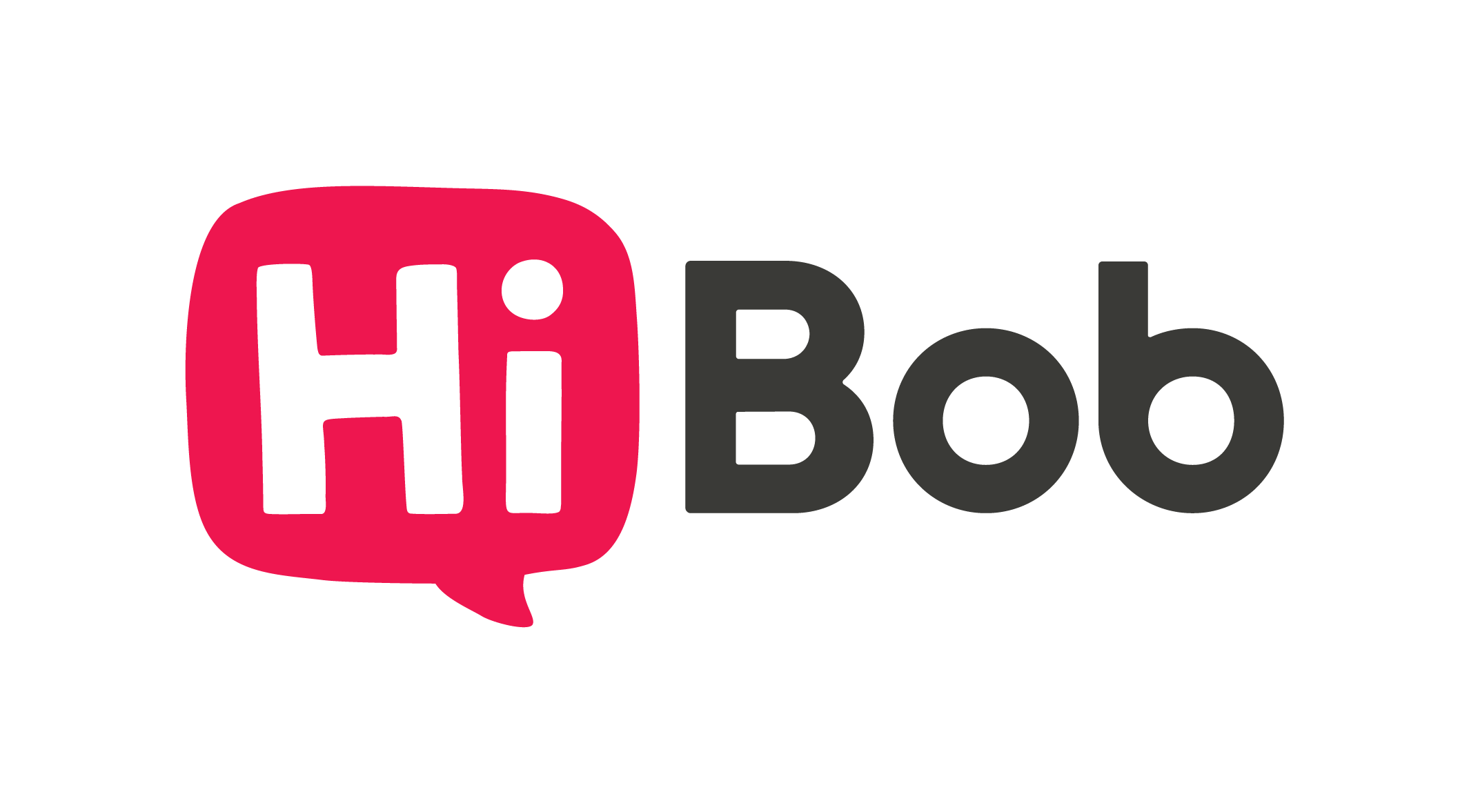
Startup leaders use HiBob’s HR software, Bob, to manage their people as their business scales.
The intuitive interface helps teams adopt the system quickly and reduces the time spent on manual tasks like collecting onboarding documents, managing time off requests, and tracking performance metrics.
Bob’s breadth of core HR functionally gives your startup team everything needed to operate efficiently, from employee self-service to time and attendance management. You can automate HR processes and gain real-time insights into your people—without getting slowed down by administrative overhead.
Bob’s flexible platform also integrates seamlessly with communication tools and payroll systems so you can connect your HR workflows to your existing tech stack.
Key features:
- Onboarding: Automate tasks, track progress, and personalize welcome flows to ensure smooth transitions for new joiners as you grow
- Performance management: Schedule regular feedback sessions, goal-setting, and 360 performance reviews to track individual growth
- Time and attendance: Track hours, vacation days, and attendance to ensure accurate paychecks
- Compensation management: Manage compensation, bonuses, and salary structures to attract and retain top talent by providing fair, competitive compensation
- Payroll: Automate salary calculations, deductions, and tax compliance across multiple locations to simplify payroll processing
- Employee engagement: Facilitate surveys and feedback to monitor team member sentiment and improve engagement
- People analytics: Generate real-time, customizable reports and KPIs to gain insights into workforce trends, turnover rates, and overall performance
- Document management: Centralize documents in a secure, digital environment for easy access and management
- Self-service: Empower team members to manage their data, request time off, and access personal documents to reduce HR’s manual workload
- Surveys and feedback: Collect feedback from pulse surveys to track engagement and areas for improvement
(This article includes platform features that reflect the information available as of the publication date.)
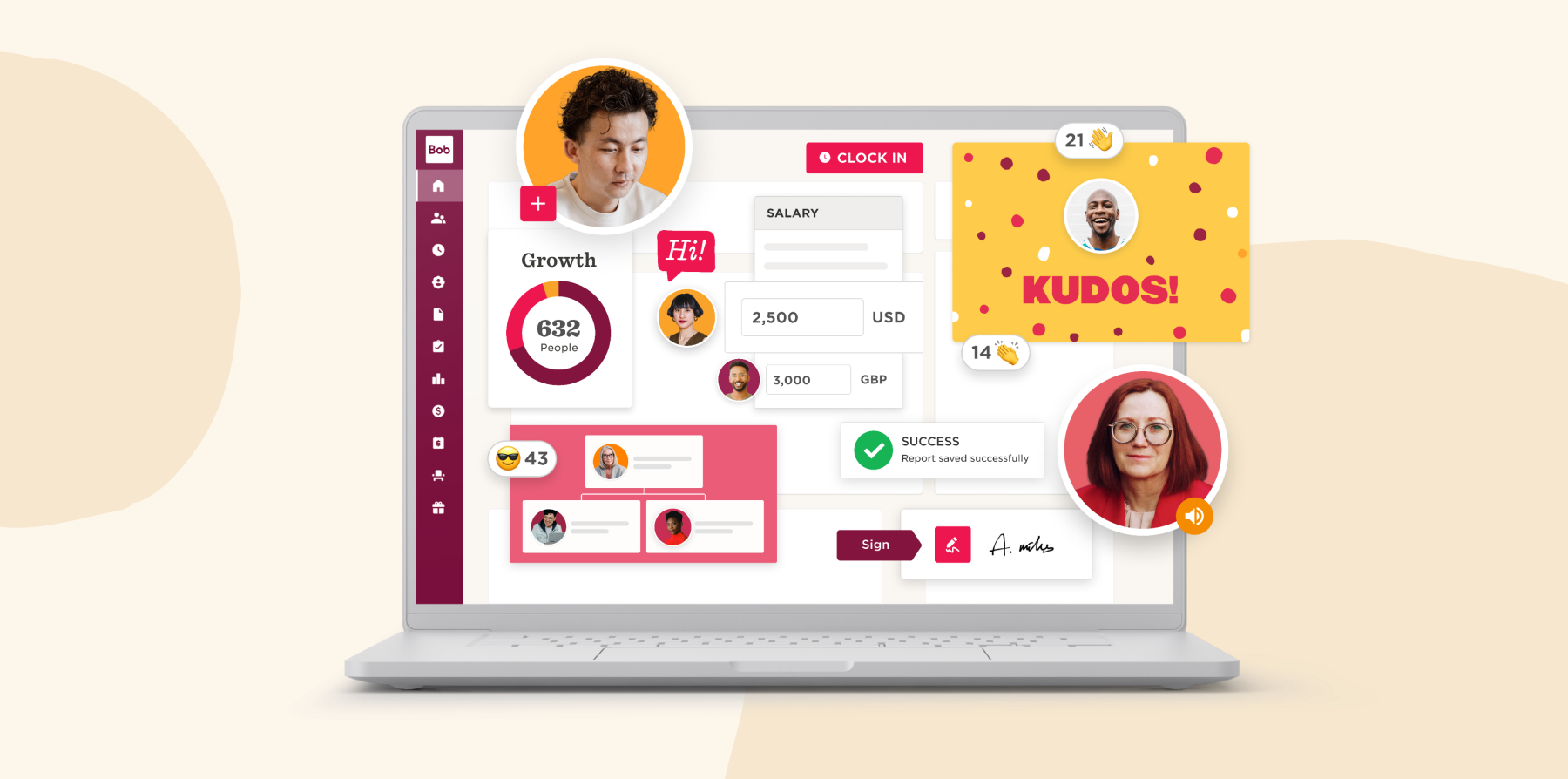
Pros:
- Offers an intuitive, easy-to-adopt platform
- Offers a full range of HR functionalities, including payroll, performance management, employee engagement, and compliance, all in one system
- Provides real-time people data and customizable reports so startups can track trends and make data-driven decisions
- Integrates seamlessly with various tools and scales with your business
- Offers workforce-wide learning programs to ensure everyone grows with the startup
- Uses real-time workforce data and sandbox environments to support smooth transitions during periods of growth
Cons:
- “No specific format for phone numbers” – verified review
- “I wish it had built-in two-factor authentication.” –verified review
(Pros and cons are compiled from reviews found on G2)
Pricing (as of publication date): HiBob pricing plans are crafted personally for HR leaders to match their needs. The flexible options let you get precisely what your HR team requires, from implementation to integrations.
BambooHR

BambooHR is a cloud-based HR platform that focuses on simplifying administrative HR processes. It helps manage employee databases and reporting, payroll and benefits, and hiring and onboarding. It’s available for use in over 150 countries.
Key features:
- Generate reports to help track trends and behaviors
- Team members can manage their personal information, request time off, and view documents
- Automatically track hours, vacation, and sick days
- Manage onboarding with customizable templates and automated task reminders
(The article includes platform features that reflect the information available as of the publication date.)
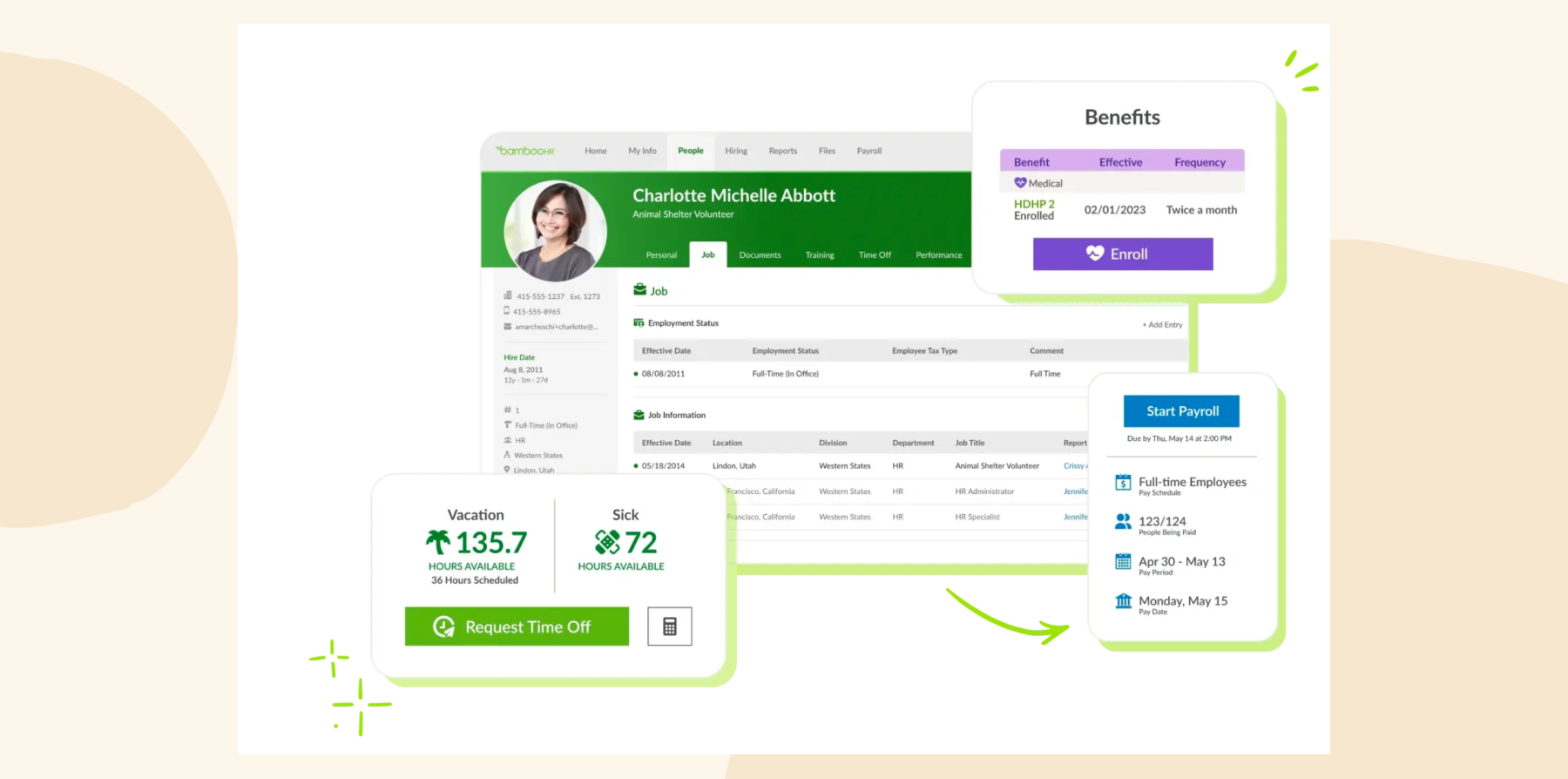
Pros:
- Keeps contracts and personal information confidential
- Centralizes all team information
Cons:
- “The main downside at the moment is the analytics capability is weak so you need to extract data and do a lot of the analysis yourself.” – verified review
- “Customer support is not always quick to resolve issues.” – verified review
(Pros and cons are compiled from reviews found on G2)
Pricing (as of publication date): BambooHR pricing is not publicly available
(Pricing plans are based on the BambooHR website and are subject to change.)
<<Compare Bob vs. BambooHR – See which fits your business best>>
Deel

Deel is a global HR platform built to help businesses manage their international workforce. It offers solutions for hiring, payroll, and compliance for remote teams. Deel’s all-in-one platform is available in over 150 countries.
Key features:
- Handle payroll, taxes, compliance, and benefits in over 150 countries
- Automate onboarding and offboarding processes
- Provide tools for people to submit time off requests and expense claims
- Centralize global team documents
(The article includes platform features that reflect the information available as of the publication date.)
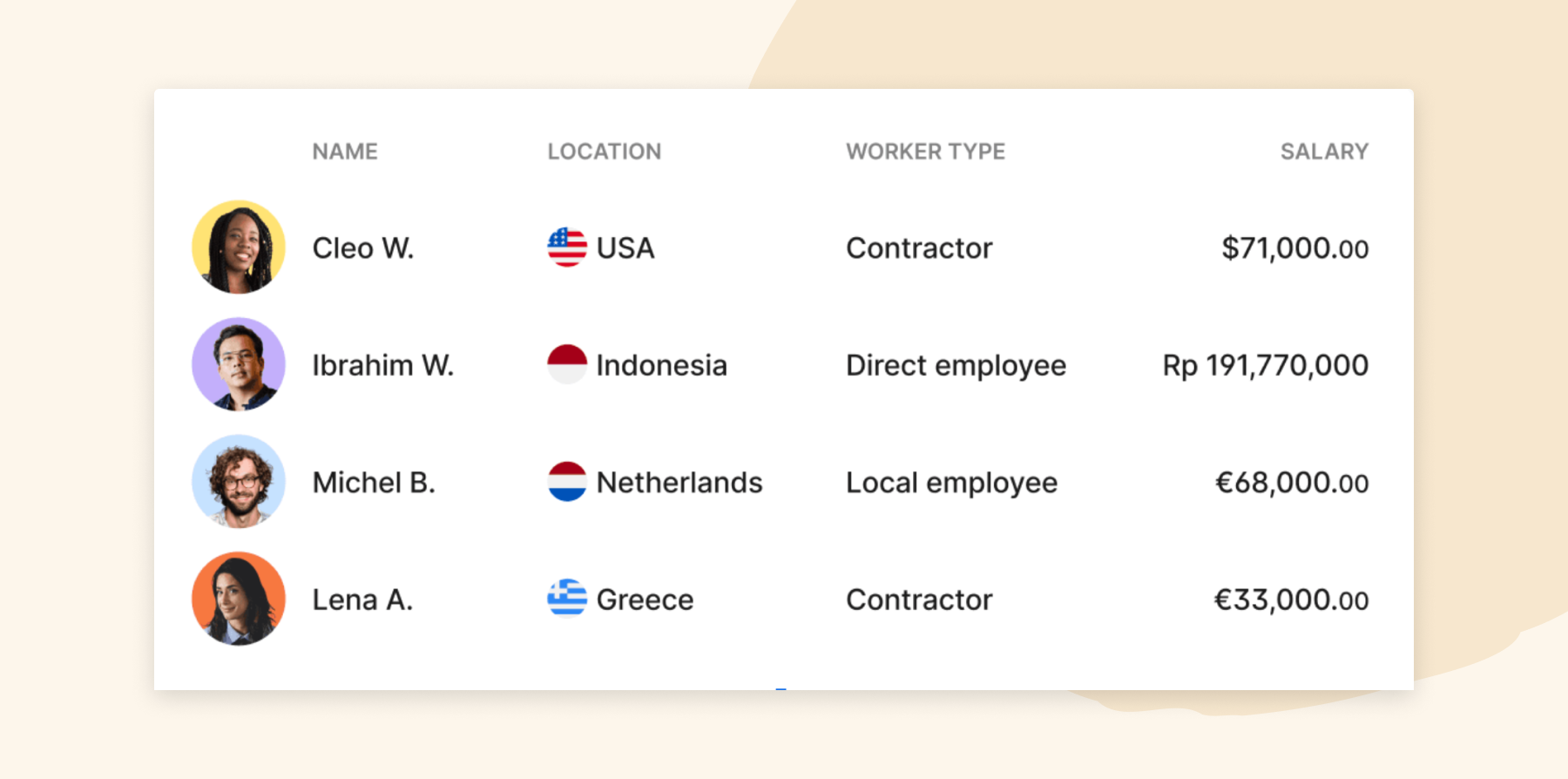
Pros:
- Allows teams to hire people globally
- Offers options to pay all international team members and contractors in one spot
Cons:
- “Onboarding was dreadful – basically sent a quote then told to use the system without any guidance.” – verified review
- “Deel is very expensive.” – verified review
(Pros and cons are compiled from reviews found on G2)
Pricing (as of publication date):
- Deel HR: Free
- Deel Engage: $20/mo per person
(Pricing plans are based on the Deel website and are subject to change.)
Gusto

Gusto is an HR platform that offers tools for payroll, benefits, and talent management. Its automation features streamline HR tasks, while its compliance tools help teams stay ahead of tax and legal requirements. Gusto also offers engagement tools for small businesses.
Key features:
- Access onboarding checklists, document e-signing, and job posting features
- Offer health, dental, vision, and 401(k) benefits
- Conduct performance reviews and engagement surveys
- Automates payroll calculations, tax filings, and direct deposits
(The article includes platform features that reflect the information available as of the publication date.)
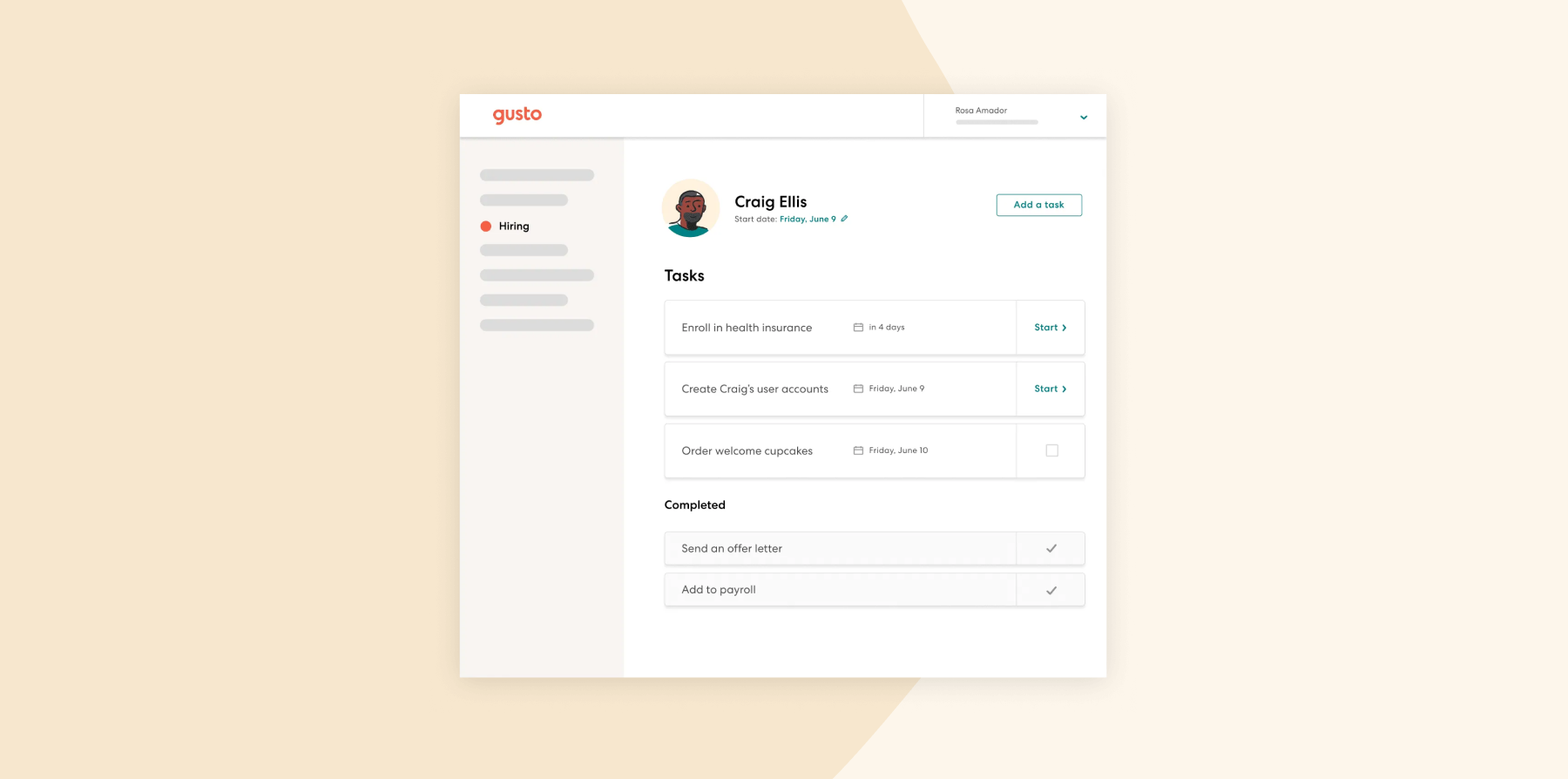
Pros:
- Consolidates personnel and payroll processes
- Offers an intuitive platform
Cons:
- “Customer service drastically changed (for the worse) in 2022.” – verified review
- “Requires a lot of additional work on our side.” – verified review
(Pros and cons are compiled from reviews found on G2)
Pricing (as of publication date):
- Simple: $40/mo plus $6/mo per person
- Plus: $60/mo plus $9/mo per person
- Premium: $135/mo plus $16.50/mo per person
(Pricing plans are based on the Gusto website and are subject to change.)
Oyster HR

Oyster is an employment management platform with HR functionalities for hiring, managing, and paying startups. The platform handles global hiring with tools to onboard people, manage payroll, and streamline benefits administration.
Key features:
- Hire full-time team members or contractors in 180+ countries
- Access pre-created local and global benefits packages
- Support payroll in over 140 countries
- Track team member hours and expenses
(The article includes platform features that reflect the information available as of the publication date.)
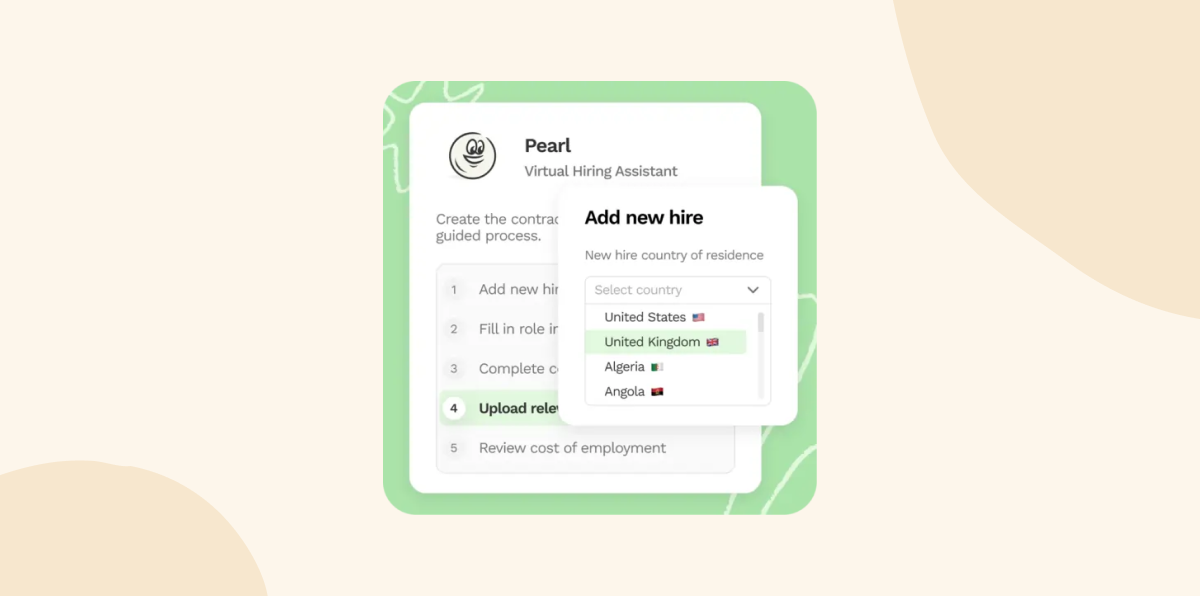
Pros:
- Provides articles in their help center that explain different topics for users
- Offers the capability to hire remote international workers
Cons:
- “You do not have a dedicated rep so you will get someone new each time.” – verified user
- “Everything has to take numerous steps to fix just one simple thing, or adjust a setting.” – verified user
(Pros and cons are compiled from reviews found on G2)
Pricing:
- Contractor: $29/mo per contractor
- Global Payroll: $25/mo per employee
- Employer of Record: $699/mo
- Scale: Pricing is not publicly available
(Pricing plans are based on the Oyster website and are subject to change.)
Paychex

Paychex offers Paychex Flex as their HR and payroll platform that streamlines HR tasks, manages benefits, and supports compliance. The HR and payroll systems sync so you can handle all related tasks in a single platform.
Key features:
- Track hours and attendance
- Automate payroll processing, tax filing, and compliance
- Manage health insurance, 401(k), and other benefits
- Allow people to view and update personal information, request time off, and access pay stubs
(The article includes platform features that reflect the information available as of the publication date.)
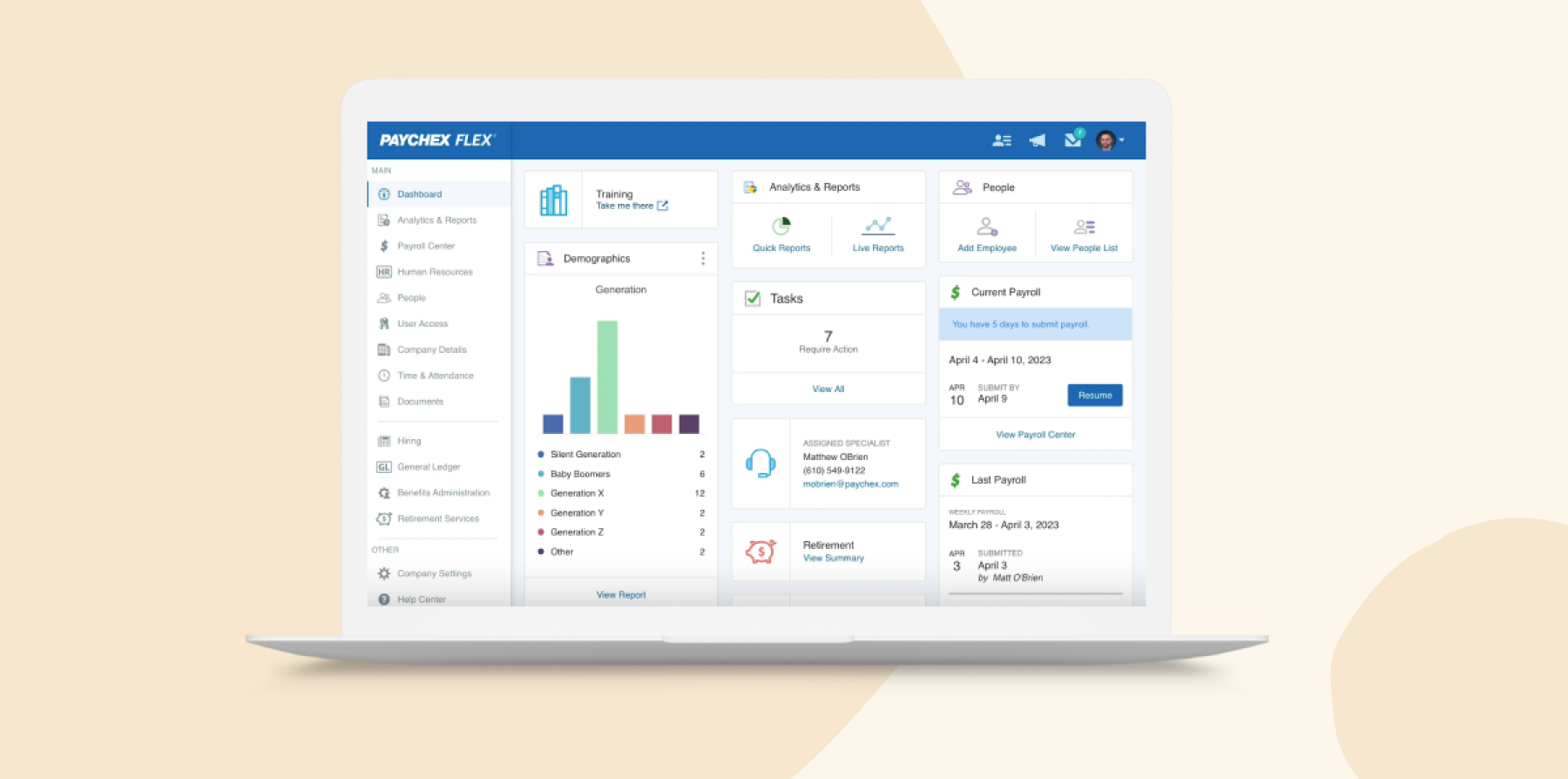
Pros:
- Features simple implementation
- Provides an easy-to-access system at work, at home, or on mobile phone
Cons:
- “Reports are not set up very well.” – verified user
- “It was not compatible with some products we utilize” – verified user
(Pros and cons are compiled from reviews found on G2)
Pricing (as of publication date): Paychex pricing is not publicly available
Personio

Personio is an HR platform that offers features that cover the entire employee lifecycle. Its automation tools and integrations can help startups streamline daily HR processes like onboarding, absence management, and time tracking.
Key features:
- Automate job postings, applicant tracking, and the onboarding flows
- Track working hours and manage vacations, sick leave, and absences
- Streamline payroll with tools for salary calculations, deductions, and tax compliance
- Enables people to manage their information
(The article includes platform features that reflect the information available as of the publication date.)
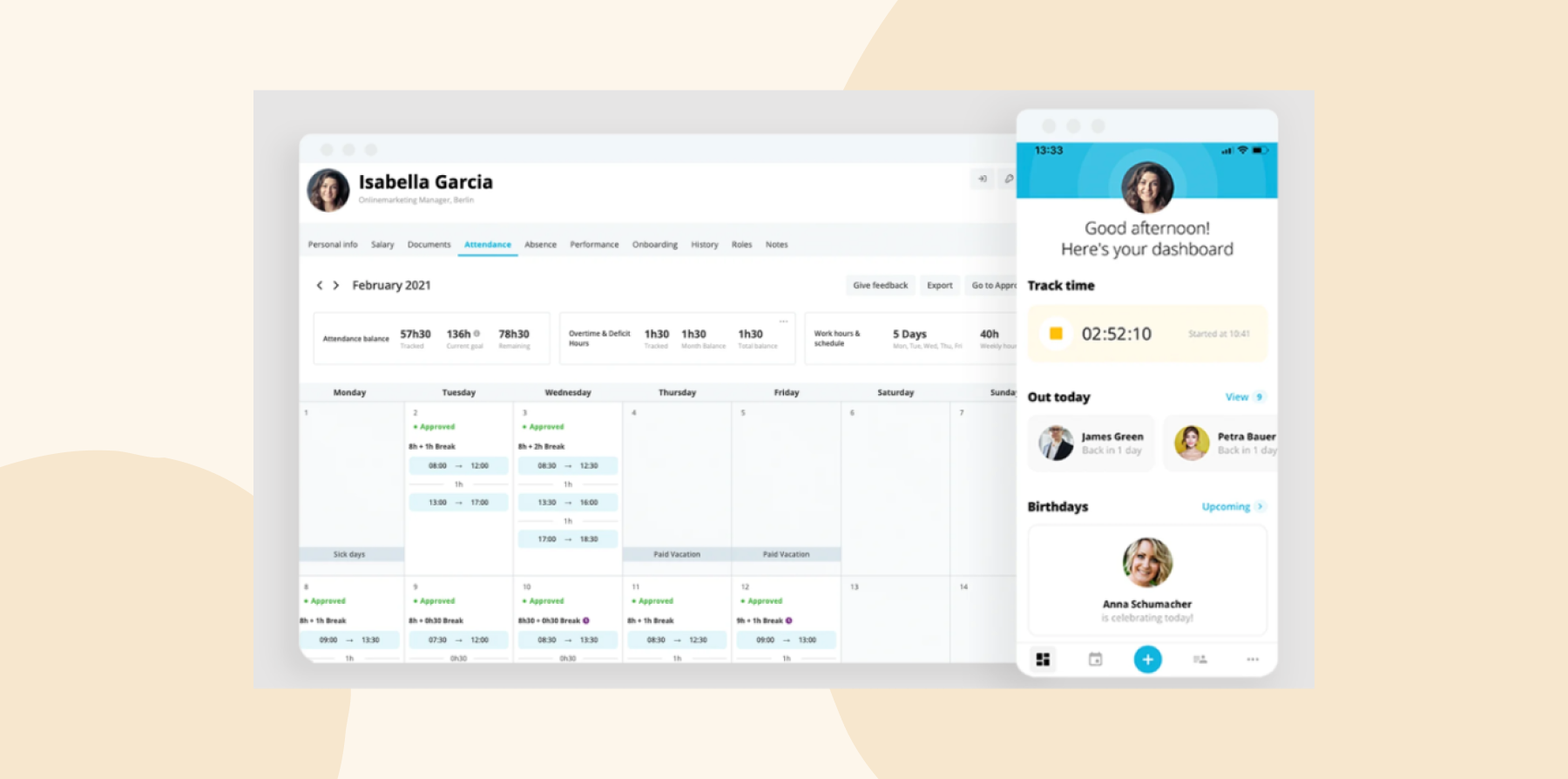
Pros:
- Offers responsive customer service
- Connects with a lot of different external tools
Cons:
- “You can’t report or easily track signed documents.” – verified user
- “The UX is simply far far behind what you’d expect a company valued this high to be.” – verified user
(Pros and cons are compiled from reviews found on G2)
Pricing (as of publication date): Personio pricing is not publicly available
<<Compare Bob vs. Personio – See which fits your business best>>
Rippling

Rippling is a platform that combines HR, IT, and finance into a single system. It’s designed to simplify the management of both global and local teams. Rippling provides startups with a single source of truth for data and operations.
Key features:
- Handle payroll and compliance with local tax laws
- Automate onboarding and offboarding processes
- Track work hours, vacation days, and attendance
- Generate real-time insights on workforce performance
(The article includes platform features that reflect the information available as of the publication date.)
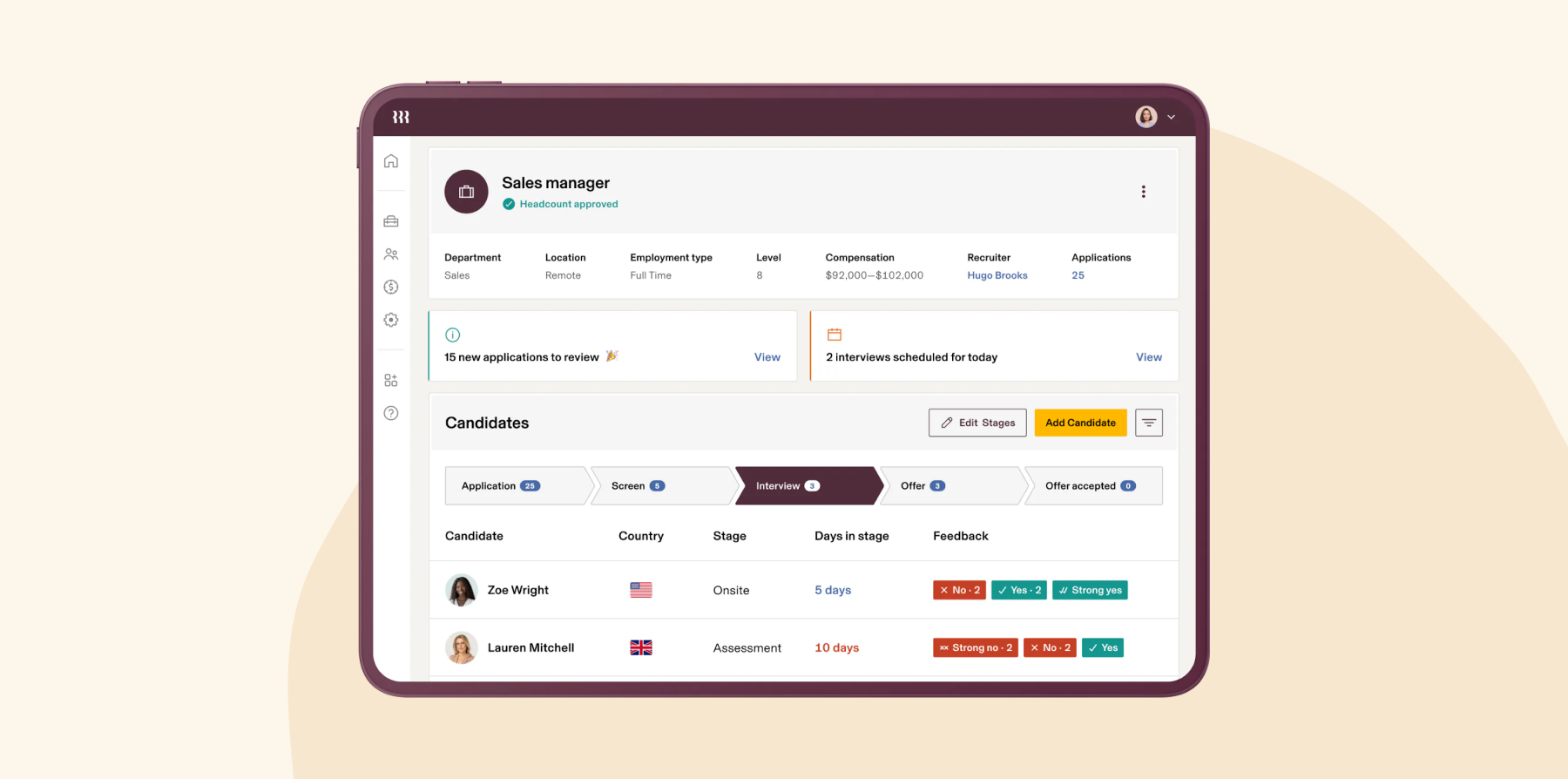
Pros:
- Offers a user-friendly interface
- Makes it easy to manage global compliance
Cons:
- “This is slower than some of the competition. Also, their sales team can be a bit pushy.” – verified user
- “At times support has provided incorrect answers which has led to issues that need to be adjusted.” – verified user
(Pros and cons are compiled from reviews found on G2)
Pricing (as of publication date): Rippling pricing is not publicly available
<<Compare Bob vs. Rippling – See which fits your business best>>
Talent HR

TalentHR is an HR platform that offers a user-friendly interface and automation features to streamline tasks like hiring, onboarding, and employee management. The platform was designed to grow with businesses of any size, startups included.
Key features:
- Automate onboarding workflows with welcome orientations
- Generate insights into people data like headcount, joiners, and departures
- Set review cycles that facilitate feedback and appraisals
- Centralize document storage and team calendars
(The article includes platform features that reflect the information available as of the publication date.)
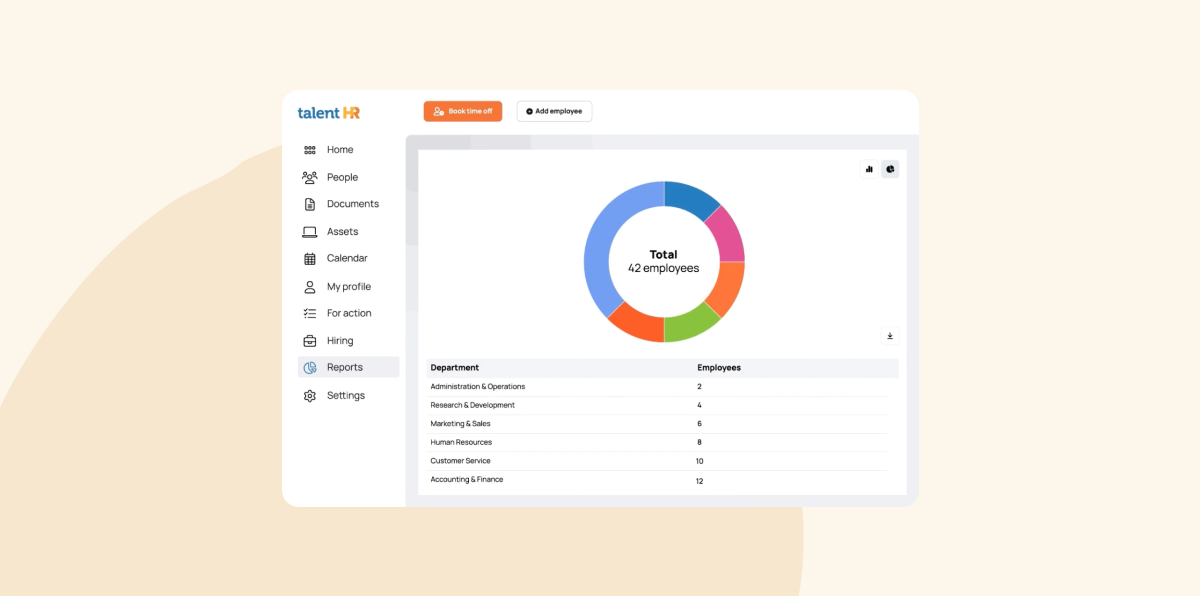
Pros:
- Offers affordable pricing
- Allows for secure information
Cons:
- “There is a slight worry that if our team grows significantly that TalentHR will no longer be able to meet our needs.” – verified review
- “Migrating our data was not very easy. ” – verified review
(Pros and cons are compiled from reviews found on Capterra)
Pricing:
- Free: Free for up to 10 user
- Essential: $2/mo per user
- Premium: $4/mo per user
(Pricing plans are based on the TalentHR website and are subject to change.)
TriNet

TriNet, previously Zenefits, offers an HR platform with payroll, benefits, and compliance solutions. It consolidates key HR functions like payroll, employee management, and hiring into one system. They also offer outsourced services for HR and payroll needs.
Key features:
- Access customizable offer letters, background checks, and digital signatures
- Automate payroll, tax filings, and compliance
- Offers benefits including health insurance, 401(k) plans, and more
- Access customizable performance review templates to set goals and manage feedback
(The article includes platform features that reflect the information available as of the publication date.)
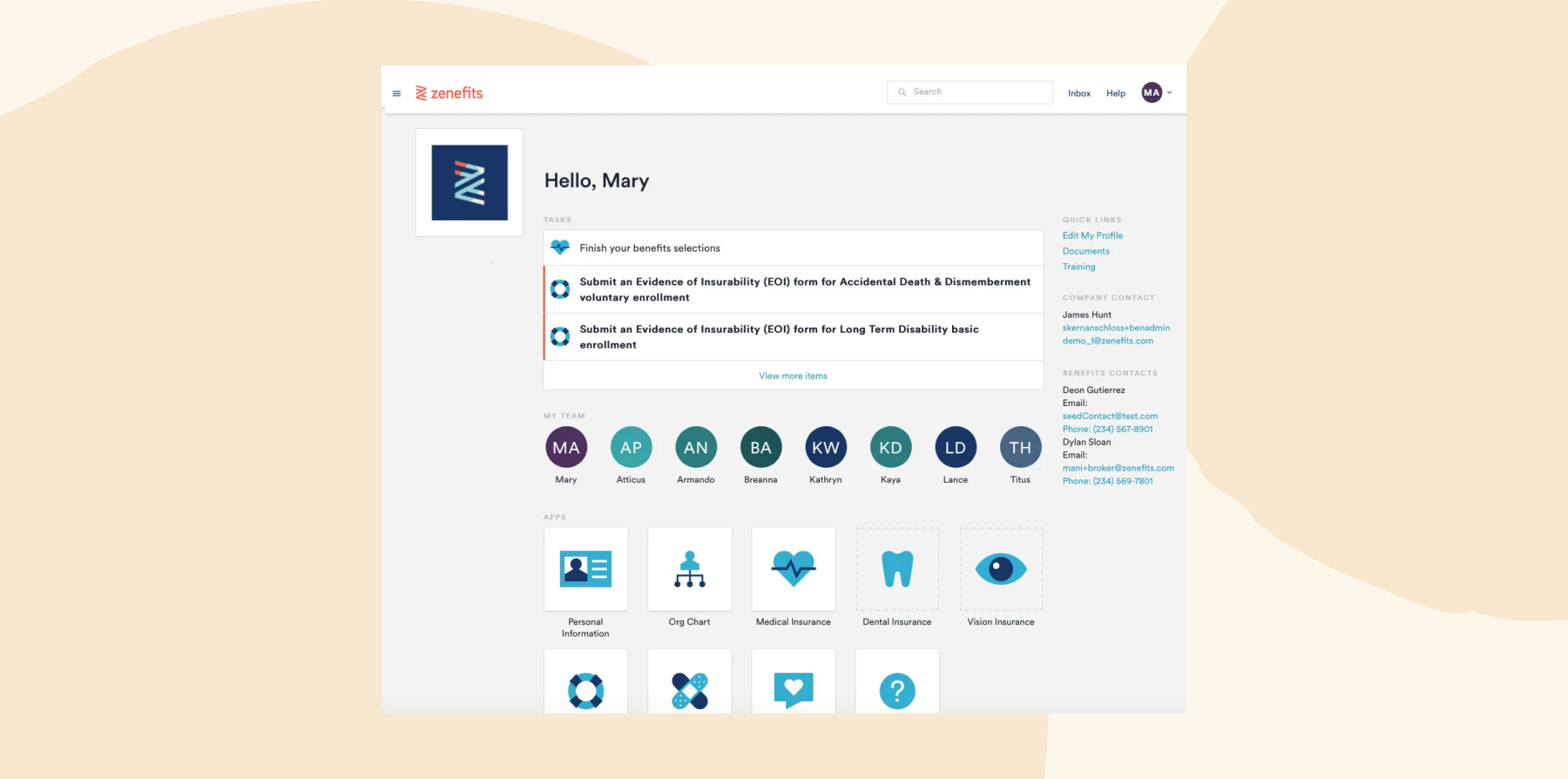
Pros:
- Offers an intuitive interface
- Allows users to access independently
Cons:
- “The amount of time spent getting new/random customer service rep up to speed with the backstory and context for a question can be rather inefficient and frustrating.” – verified user
- “Difficult to transition from another system into this one. Data transfer is a bit clunky” – verified user
(Pros and cons are compiled from reviews found on G2)
Pricing (as of publication date): TriNet pricing is not publicly available
Workable
Workable is an HR platform that helps businesses streamline the hiring and team member management process. Workable’s AI-powered tools support recruitment, onboarding, and people management and reduce time spent on repetitive HR tasks.
Key features:
- Automate job posting across 200+ job boards
- Access customizable onboarding workflows, welcome portals, and e-signature documents
- Access dynamic profiles, org chart management, and document storage
- Enable people to request and track time off, with automated accrual policies and approvals
(The article includes platform features that reflect the information available as of the publication date.)
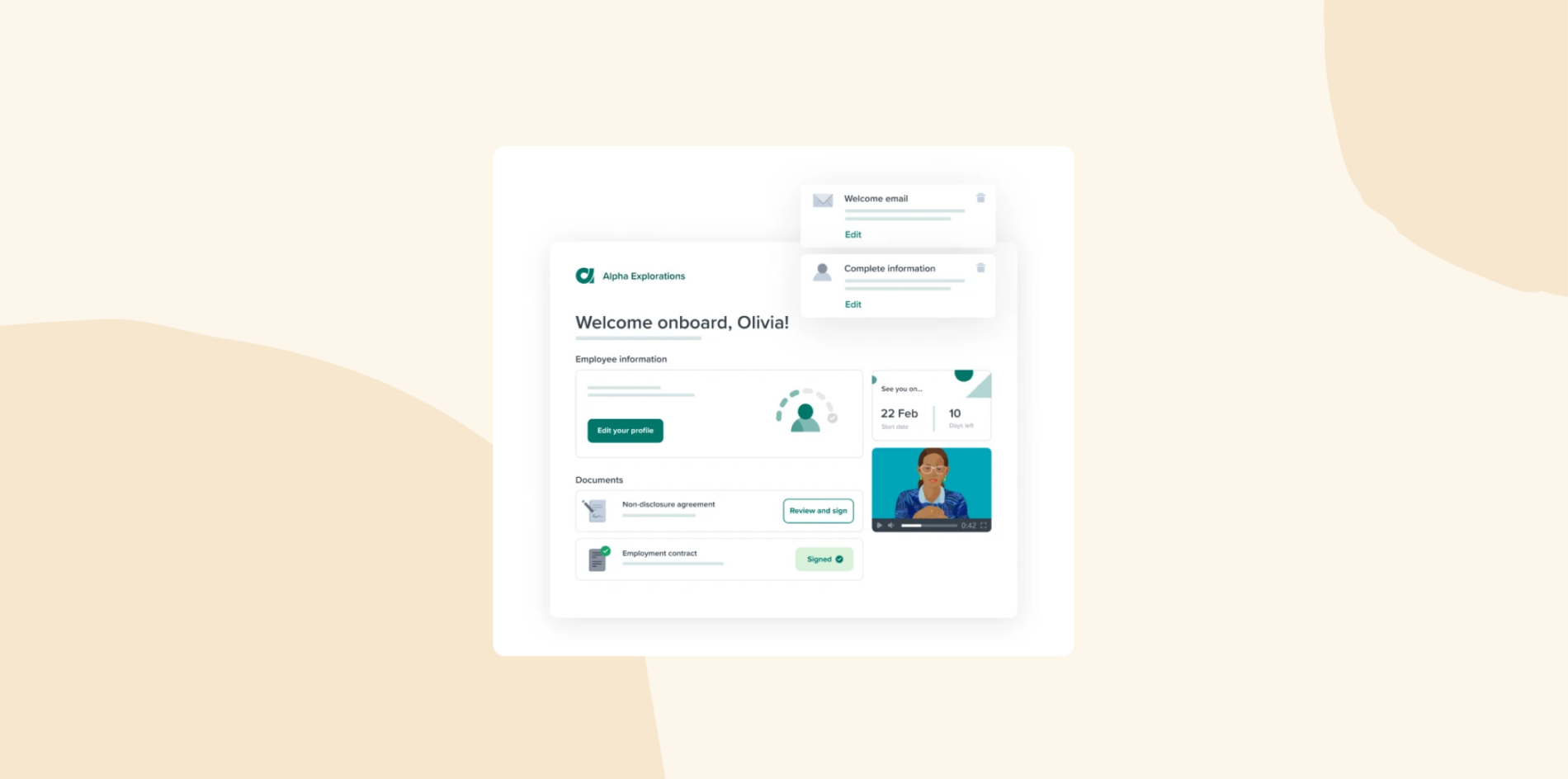
Pros:
- Incorporates AI to streamline the hiring process
- Offers a clear and easy to use display
Cons:
- “The platform is very slow and often buggy.” – verified user
- “It is not easy to integrate with some platforms.” – verified user
(Pros and cons are compiled from reviews found on G2)
Pricing:
- Starter: $189/mo for up to 20 people
- Standard: Starts at $378/mo
- Premier: Starts at $628/mo
(Pricing plans are based on the Workable website and are subject to change.)
Benefits of using HR software with your startup
Let’s look at how HR software can help you scale your startup—without needing additional headcount.
Reduces human error through automation
Use automated workflows to prevent costly mistakes in everything from payroll to personal details. Automation also reduces the time your team spends on manual, time-consuming processes.
Improves decision making
Access to real-time data and reports can uncover deep insights into your team’s work trends and behaviors, like turnover, engagement, and performance. Use actionable insights to spot trends, plan for changes, and make strategic moves that help your startup thrive.
Increases employee engagement
HR software can impact engagement in several ways.
- Promote regular and open communication through surveys, feedback mechanisms, and peer recognition systems, so team members feel heard and connected
- Provide recognition programs that help people receive timely appreciation and support to reinforce their value within the organization
- Offer development opportunities that align with employee career goals
These tools help build a supportive work environment that fosters trust, boosts morale, and enhances overall engagement. When everything runs smoothly—and everyone feels recognized and valued—your team can get straight into their productive flow.
Streamlines compliance
HR software can help teams navigate complex labor laws and regulations. Automated updates and reminders about compliance changes keep your business ahead of regulatory shifts, securing a protective shield around your operational practices.
FAQs on startup HR software
Which is the best HR software for startups?
If you need a solution that manages HR tasks, streamlines payroll, and scales with your company as it grows, try Bob. Bob offers an intuitive interface that’s easy for your people to adopt—saving you time and resources from day one.
When should a startup get an HR system?
Startups should consider using HR software when manual processes like payroll, time tracking, or onboarding are becoming hard to manage. If your team finds itself stretched thin or you’re experiencing rapid growth, investing in an HR solution early on can help you stay organized and support your people effectively as you grow.
Recommended For Further Reading
- HR system implementation checklist for proper implementation
- HR software explained: Unpacking the basics of human resources software
- How to choose an HR software for your small business
- Best HRIS systems for small businesses
- Best HRIS for medium businesses
- Onboarding software for small businesses
- Best applicant tracking systems for small businesses and startups
How do I set up an HR system?
Follow this implementation checklist to properly plan and set up your HR system:
- Create a plan: Define your goals, timeline, budget, and assign responsibilities
- Find the right software: List out system requirements, research vendors, compare features, and conduct demos to choose the best solution
- Configure and install the system: Work with IT to configure the system, import data, and integrate it with existing tools
- Test the system: Run tests to ensure functionality, validate data accuracy, and address any issues or concerns
- Train and onboard your team: Host training sessions for HR and staff, and provide guides for continued support
- Rollout the system: Decide on a rollout strategy (gradual or full launch), communicate the plan internally, and ensure IT support is available
- Monitor and iterate: Gather feedback, provide ongoing support, and make necessary updates to the system based on user input
Choose the best HR software for your startup
In a startup environment, culture is critical—it fosters collaboration, innovation, and a sense of community among team members. The right HR software allows startups to automate time-consuming tasks, freeing up HR teams to focus on what really matters: its people.
For startups looking for a platform that handles all your HR needs in one place, consider Bob. With an intuitive platform, robust analytics, and seamless integration capabilities, you can keep your team productive at every stage of growth.
Disclaimer: The opinions expressed here are solely those of the author and do not necessarily reflect the views of the company. Prospective users are encouraged to conduct their own research to make the best decision for their organization.


